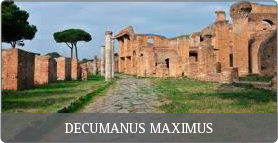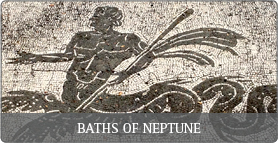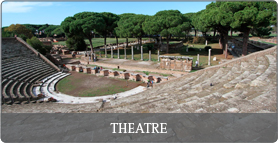If you don't have enough time to go to Pompeii,
then Ostia Antica is a great substitute and less crowded as well. Moreover it's very close to Rome.
Ostia was the commercial port of Ancient Rome.
According to tradition, it was founded by the fourth king of Rome, Ancus Marcius and between the 1st and the 2nd century AD Ostia became the main emporium of Rome.
The Excavations began in 1942 and two-thirds of the city were brought to light.
Nowadays Ostia is a large archaeological site, noted for the excellent preservation of its buildings, frescoes and mosaics.
You'll meet the guide before the entrance and then walk with him along the Decumanus Maximus, the main street. You'll feel as though you are walking amongst the ancient Romans themselves.
Along the way you'll find the Baths of Neptune, named after the beautiful black-and-white mosaics depicting the God of Water. Than you’ll see the Firemen's Barracks where four hundred fire fighters (vigiles) lived. The tour continues in the Square of the Guilds, a market square, where traders met ship owners and shipped goods all around the Mediterranean sea. Behind this is the Theatre.
Built in the 1st century BC and enlarged several times, it could hold 4000 spectators. Sit down on the cavea (tier) and imagine watching masked actors performing their comedies or tragedies.
Don't forget to get something to drink at the House of the Wine-bar, a small roman cafe perfectly preserved where you can still see the counter used to serve food and wine.
Then you'll reach the Forum, the main square of Ostia, dominated by the Capitolium, a massive temple dedicated to the main Roman deities.
then Ostia Antica is a great substitute and less crowded as well. Moreover it's very close to Rome.
Ostia was the commercial port of Ancient Rome.
According to tradition, it was founded by the fourth king of Rome, Ancus Marcius and between the 1st and the 2nd century AD Ostia became the main emporium of Rome.
The Excavations began in 1942 and two-thirds of the city were brought to light.
Nowadays Ostia is a large archaeological site, noted for the excellent preservation of its buildings, frescoes and mosaics.
You'll meet the guide before the entrance and then walk with him along the Decumanus Maximus, the main street. You'll feel as though you are walking amongst the ancient Romans themselves.
Along the way you'll find the Baths of Neptune, named after the beautiful black-and-white mosaics depicting the God of Water. Than you’ll see the Firemen's Barracks where four hundred fire fighters (vigiles) lived. The tour continues in the Square of the Guilds, a market square, where traders met ship owners and shipped goods all around the Mediterranean sea. Behind this is the Theatre.
Built in the 1st century BC and enlarged several times, it could hold 4000 spectators. Sit down on the cavea (tier) and imagine watching masked actors performing their comedies or tragedies.
Don't forget to get something to drink at the House of the Wine-bar, a small roman cafe perfectly preserved where you can still see the counter used to serve food and wine.
Then you'll reach the Forum, the main square of Ostia, dominated by the Capitolium, a massive temple dedicated to the main Roman deities.



